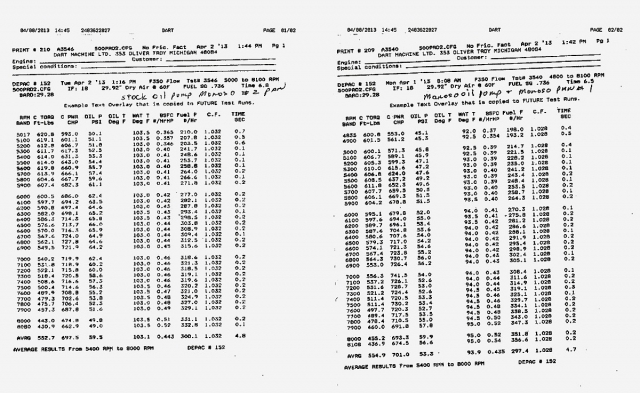Dart’s new LS Next iron cylinder block is one step closer to hitting the market following a series of oil-system tests. The block was first shown at the SEMA show last November, and it’s designed to take advantage of the LS engine’s positive attributes while removing the negatives from the equation. Basically, the new block supports LS cylinder heads and other major components but replaces the troublesome Y-block side skirts with Gen I-style main caps and oil-pan rails. The result is less crank windage and stronger main web.
 The oiling system was the most critical issue that company founder Richard Maskin and his team tackled during the block’s development. The first test used an external pump and a modified Moroso Rocket-block pan core. The second test utilized a stock LS oil pump, which was modified with a weaker pressure spring, and a Moroso LS oil pan with pan rail spacers to make up the difference in the skirt length. These adjustments maintained the oil desired oil pressure in the engine without the excessive volume that the LS often requires.
The oiling system was the most critical issue that company founder Richard Maskin and his team tackled during the block’s development. The first test used an external pump and a modified Moroso Rocket-block pan core. The second test utilized a stock LS oil pump, which was modified with a weaker pressure spring, and a Moroso LS oil pan with pan rail spacers to make up the difference in the skirt length. These adjustments maintained the oil desired oil pressure in the engine without the excessive volume that the LS often requires.
“According to my sources, the stock LS7 uses somewhere around 18 gallons per minute revved up, while our design uses much less and still provides more-than-adequate oiling across the board,” explains Maskin. “So far, we’ve created two blocks – the first one was cut up for inspection, and the block used for this test was number two. Now that the initial testing has been run, we plan to pour 25 production blocks next week, which will be available for purchase on or about the first of May.
“We’ve got two more tests to run,” continues Maskin. “The first being a Pro Stock dry-sump system with 25 inches or more of vacuum to see what power potential is really in the oiling system. For the second test, we’ll be going back to the stock pump with an all-out, baffled, screened, wet-sump oil pan.”
More power than expected
The test engine was fitted with Dart’s CNC-machined LS1 heads, a “reasonably small” solid-roller cam, GM intake and 850cfm carb.
“As far as performance goes, there are plenty of performance parts out there – heads, manifolds, etc. that are much better than what we used in this engine,” says Maskin. “We were just trying to prove that the block worked as it was designed to work.”
Experts at Lingenfelter Performance and Nickens Racing Engines had earlier suggested to Maskin that the engine with those parts would make about 640 to 660 horsepower. As indicated by the dyno results below, the engine hit a peak of 740 horsepower and averaged 701 horsepower from 5,600 to 8,000 rpm.
 Dart’s new LS Next block features 4-bolt steel main caps with 7/16-inch bolts and full main webbing for maximum bottom-end strength. The cylinder barrels are .375-inch longer for better piston support and ring seal. It comes with a 9.240-inch deck height and 5/8-inch deck thickness. The siamesed cylinder bores can be opened up to 4.200 inches, allowing for large-displacement options.
Dart’s new LS Next block features 4-bolt steel main caps with 7/16-inch bolts and full main webbing for maximum bottom-end strength. The cylinder barrels are .375-inch longer for better piston support and ring seal. It comes with a 9.240-inch deck height and 5/8-inch deck thickness. The siamesed cylinder bores can be opened up to 4.200 inches, allowing for large-displacement options.
The block also features blind head bolts: four 7/16-inch head bolts, one 3/8-inch and one stock-sized inner hole per cylinder to improve clamp force in power-adder applications. There are provisions for oil restrictors in the lifter valley to complement the low-volume, priority main oiling system. LSX-style lifter bosses and dog-bone provisions are also included with the LS Next block – it will easily accommodate 1.060-inch bushings with .937-inch lifters. The block also features a Pro Stock/Pro Mod-type big-block style stepped main oil galley. Lastly, the water jacket around the No. 1 cylinder has been expanded as well as around the outside of each cylinder barrel for additional cooling capacity.
- Bore: 4.155 inch
- Stroke: 4.00 inch
- Rod Length: 6.125 inch
- Compression Ratio: 12.5:1
- Pistons: Mahle flat top
- Engine Bearings: Clevite
- Camshaft: Mechanical roller 255/265 duration, .670-inch lift
- Rocker: Harland Sharp Roller
- Heads: Dart w/ 2.08-inch I/1.60-inch E
- Intake: Chevy Performance single plane
- Carburetor: Demon 850cfm
- Ignition: HEI, with 30 degrees timing
- Oil Pump: Moroso external, Melling stock replacement
- Oil Pan: Moroso
- Headers: Hedman
Check out this interview with Richard Maskin from the 2012 PRI show as he discusses the LS Next block.




















